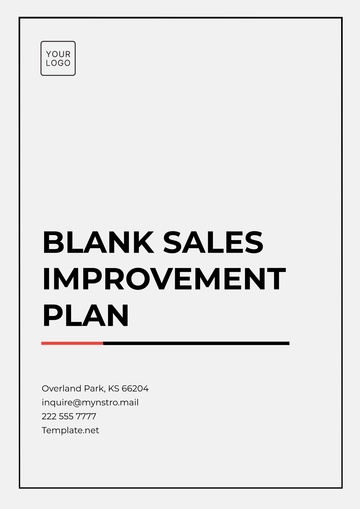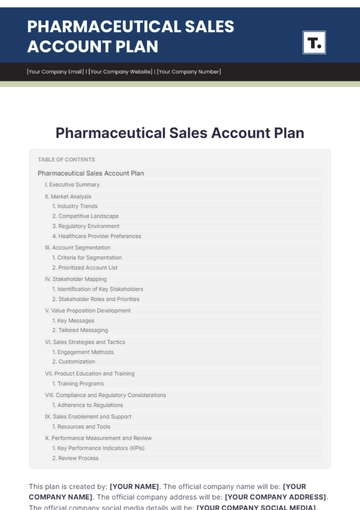Free SEO Agency Sales Plan Outline

Prepared by: [YOUR NAME]
Date: [DATE]
I. Executive Summary
Overview: Summary of the SEO agency’s sales goals and strategies to increase client acquisition, retention, and revenue growth.
Mission Statement: Outline the agency's commitment to providing effective SEO solutions for clients.
Goals: Short-term and long-term sales objectives (e.g., increase monthly sales by 20%, onboard 10 new clients in the next quarter).
II. Market Analysis
Industry Overview: Provide insights into the SEO industry, trends, and market potential.
Target Market: Identify key industries or businesses that require SEO services, such as e-commerce, healthcare, or real estate.
Competitive Landscape: Analyze competitors, their strengths, weaknesses, pricing, and unique selling points (USPs).
Customer Needs: Highlight common challenges businesses face with SEO and how your agency’s services address them.
III. Sales Objectives
Revenue Targets: Set specific financial targets for the next 6 months, 1 year, and beyond (e.g., $500,000 in revenue within the first year).
Client Acquisition Goals: Set specific numbers for new clients or contracts (e.g., sign 20 new clients in the next quarter).
Client Retention Goals: Focus on retaining existing clients and encouraging repeat business.
Lead Generation: Set goals for generating a certain number of qualified leads each month.
IV. Target Audience
Ideal Client Profiles: Describe the type of clients you aim to attract, including their industry, size, budget, and SEO needs.
Customer Personas: Define detailed buyer personas that represent your ideal clients (e.g., a small business owner in need of local SEO).
Pain Points: Highlight the specific SEO challenges that these clients face (e.g., low website traffic, poor search rankings, or a lack of content strategy).
V. Sales Strategies and Tactics
Lead Generation:
Content marketing (blogs, webinars, case studies).
Social media outreach (LinkedIn, Facebook Ads).
Paid advertising (Google Ads, PPC campaigns).
Networking (industry events, partnerships).
Sales Funnel Development:
Top of the Funnel (TOFU): Attract leads through awareness and educational content.
Middle of the Funnel (MOFU): Nurture leads with free resources, consultations, or SEO audits.
Bottom of the Funnel (BOFU): Convert leads with customized proposals, case studies, and clear calls to action Outreach:
Cold emails and personalized messaging.
Follow-ups and relationship-building with potential clients.
Referral Programs: Implement a referral system to incentivize current clients to bring in new business.
VI. Pricing Structure
Package Offerings:
Basic SEO Package: Targeting small businesses or local SEO needs.
Advanced SEO Package: For medium to large businesses requiring a more extensive SEO strategy.
Custom SEO Services: Tailored plans for enterprise clients or niche industries.
Pricing Model: Provide clear pricing details, whether flat-rate, hourly, or retainer-based.
Discounts and Promotions: Offer limited-time discounts or promotional packages to attract new clients.
VII. Sales Team Roles
Sales Manager: Oversees the overall sales strategy and performance.
Sales Representatives: Engage in direct sales outreach, manage leads, and close deals.
Account Managers: Work with existing clients to ensure long-term satisfaction and growth.
Marketing Team: Support the sales team with lead-generation materials, campaigns, and content.
VIII. Metrics and KPIs
Lead Conversion Rate: Percentage of leads that convert into paying clients.
Customer Lifetime Value (CLV): Average revenue generated per client throughout their relationship.
Client Retention Rate: Measure the percentage of clients retained over time.
Revenue Growth: Monitor monthly and yearly revenue growth rates.
Sales Team Performance: Track individual sales reps based on the number of leads generated, meetings booked, and deals closed.
IX. Budget and Resources
Sales and Marketing Budget: Allocate funds for lead generation activities, marketing campaigns, tools, and sales team salaries.
Technology Tools: Invest in CRM systems, analytics platforms, email automation tools, and SEO reporting tools to support the sales process.
Training and Development: Budget for ongoing sales training, SEO certifications, and other professional development opportunities for the sales team.
- 100% Customizable, free editor
- Access 1 Million+ Templates, photo’s & graphics
- Download or share as a template
- Click and replace photos, graphics, text, backgrounds
- Resize, crop, AI write & more
- Access advanced editor
Boost your agency's client conversion rates with the SEO Agency Sales Plan Outline Template from Template.net. This editable and customizable template offers a detailed structure for outlining your agency’s sales approach, from lead generation to closing deals. Tailor it to your agency's services and target audience. The editable design in our Ai Editor Tool makes it easy to adjust the plan, ensuring it aligns with your sales objectives.
You may also like
- Finance Plan
- Construction Plan
- Sales Plan
- Development Plan
- Career Plan
- Budget Plan
- HR Plan
- Education Plan
- Transition Plan
- Work Plan
- Training Plan
- Communication Plan
- Operation Plan
- Health And Safety Plan
- Strategy Plan
- Professional Development Plan
- Advertising Plan
- Risk Management Plan
- Restaurant Plan
- School Plan
- Nursing Home Patient Care Plan
- Nursing Care Plan
- Plan Event
- Startup Plan
- Social Media Plan
- Staffing Plan
- Annual Plan
- Content Plan
- Payment Plan
- Implementation Plan
- Hotel Plan
- Workout Plan
- Accounting Plan
- Campaign Plan
- Essay Plan
- 30 60 90 Day Plan
- Research Plan
- Recruitment Plan
- 90 Day Plan
- Quarterly Plan
- Emergency Plan
- 5 Year Plan
- Gym Plan
- Personal Plan
- IT and Software Plan
- Treatment Plan
- Real Estate Plan
- Law Firm Plan
- Healthcare Plan
- Improvement Plan
- Media Plan
- 5 Year Business Plan
- Learning Plan
- Marketing Campaign Plan
- Travel Agency Plan
- Cleaning Services Plan
- Interior Design Plan
- Performance Plan
- PR Plan
- Birth Plan
- Life Plan
- SEO Plan
- Disaster Recovery Plan
- Continuity Plan
- Launch Plan
- Legal Plan
- Behavior Plan
- Performance Improvement Plan
- Salon Plan
- Security Plan
- Security Management Plan
- Employee Development Plan
- Quality Plan
- Service Improvement Plan
- Growth Plan
- Incident Response Plan
- Basketball Plan
- Emergency Action Plan
- Product Launch Plan
- Spa Plan
- Employee Training Plan
- Data Analysis Plan
- Employee Action Plan
- Territory Plan
- Audit Plan
- Classroom Plan
- Activity Plan
- Parenting Plan
- Care Plan
- Project Execution Plan
- Exercise Plan
- Internship Plan
- Software Development Plan
- Continuous Improvement Plan
- Leave Plan
- 90 Day Sales Plan
- Advertising Agency Plan
- Employee Transition Plan
- Smart Action Plan
- Workplace Safety Plan
- Behavior Change Plan
- Contingency Plan
- Continuity of Operations Plan
- Health Plan
- Quality Control Plan
- Self Plan
- Sports Development Plan
- Change Management Plan
- Ecommerce Plan
- Personal Financial Plan
- Process Improvement Plan
- 30-60-90 Day Sales Plan
- Crisis Management Plan
- Engagement Plan
- Execution Plan
- Pandemic Plan
- Quality Assurance Plan
- Service Continuity Plan
- Agile Project Plan
- Fundraising Plan
- Job Transition Plan
- Asset Maintenance Plan
- Maintenance Plan
- Software Test Plan
- Staff Training and Development Plan
- 3 Year Plan
- Brand Activation Plan
- Release Plan
- Resource Plan
- Risk Mitigation Plan
- Teacher Plan
- 30 60 90 Day Plan for New Manager
- Food Safety Plan
- Food Truck Plan
- Hiring Plan
- Quality Management Plan
- Wellness Plan
- Behavior Intervention Plan
- Bonus Plan
- Investment Plan
- Maternity Leave Plan
- Pandemic Response Plan
- Succession Planning
- Coaching Plan
- Configuration Management Plan
- Remote Work Plan
- Self Care Plan
- Teaching Plan
- 100-Day Plan
- HACCP Plan
- Student Plan
- Sustainability Plan
- 30 60 90 Day Plan for Interview
- Access Plan
- Site Specific Safety Plan





























